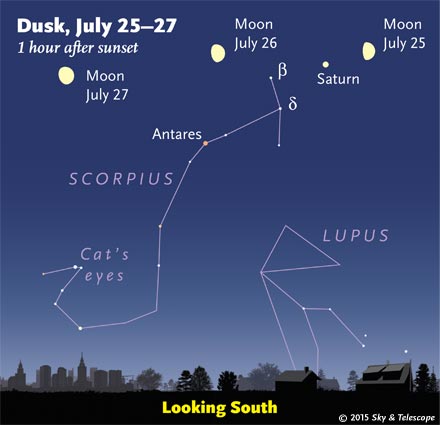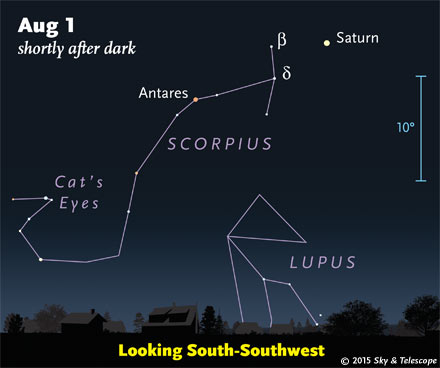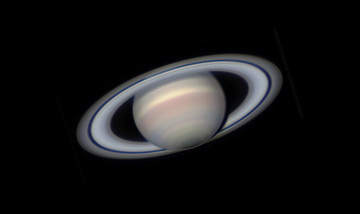Friday, July 24
• The Moon, just past first quarter, appears more than halfway from Spica (far to its lower right) to Saturn (off to the Moon's left). Much closer to the Moon, look for fainter Alpha Librae (Zubenelgenubi), a very wide double star for binoculars.
Saturday, July 25
• Ceres is at opposition. The first-discovered asteroid glimmers south of Capricornus at magnitude 7.5, within binocular reach. Use the finder chart in the July Sky & Telescope, page 50.
• The waxing gibbous Moon poses to the right of Saturn this evening, as shown below.

Sunday, July 26
• The Moon at dusk shines over Antares and left of Saturn, as shown above.
• The tail of Scorpius is low due south right after dark. How low depends on how far north you live. Look for the two stars especially close together in the tail. These are Lambda and fainter Upsilon Scorpii, known as the Cat's Eyes. They're canted at an angle; the cat is tilting his head and winking. See the illustration above.
The Cat's Eyes point west (right) by nearly a fist-width toward Mu Scorpii, a much tighter pair known as the Little Cat's Eyes. Can you resolve Mu without using binoculars? (It's shown as single on the illustration above.)
Monday, July 27
• Altair shines high in the southeast after nightfall. Just above it, by a finger-width at arm's length, is little orange Tarazed. A bit more than a fist-width to Altair's left, look for Delphinus, the Dolphin, leaping leftward.
Tuesday, July 28
• After dark, the Big Dipper hangs diagonally in the northwest. Most of its stars are about 80 light-years away. Follow the curve of its handle around by a little more than a Dipper-length and there's bright Arcturus, due west. Arcturus is the nearest orange-giant star, 37 light-years away.
Wednesday, July 29
• We're not quite halfway through summer, but Cassiopeia, a constellation associated with fall and winter, is already climbing up in the north-northeast after dark. And the Great Square of Pegasus, emblem of fall, is up and balancing on one corner on the east-northeast horizon.
Thursday, July 30
• Full Moon tonight and tomorrow (exactly full at 6:43 a.m. Friday morning Eastern Daylight Time). On Thursday evening the Moon rises just before sunset. After dark, can you see through the moonlight that it's in dim Capricornus?
This is the second full Moon in the month, sometimes called a "Blue Moon."
Friday, July 31
• This evening, skywatchers in the Americas see the Moon rise about a half day past the moment when it's exactly full. Can you detect the slightest out-of-roundness in the Moon's profile yet?

Saturday, August 1
• The Moon, now between Capricornus and Aquarius, is 1½ days past full when it rises this evening (for the Americas). Now the start of its waning gibbous phase is more definite.
• Today is Lammas Day or Lughnasadh, one of the four traditional "cross-quarter" days midway between the solstices and equinoxes. Sort of. The actual midpoint between the June solstice and the September equinox this year comes at 8:29 a.m. August 7th Eastern Daylight Time (12:29 UT). That's the exact center of astronomical summer.
__________________________
Want to become a better astronomer? Learn your way around the constellations. They're the key to locating everything fainter and deeper to hunt with binoculars or a telescope.
This is an outdoor nature hobby. For an easy-to-use constellation guide covering the whole evening sky, use the big monthly map in the center of each issue of Sky & Telescope, the essential guide to astronomy.

Once you get a telescope, to put it to good use you'll need a detailed, large-scale sky atlas (set of charts). The standards are the little Pocket Sky Atlas, which shows stars to magnitude 7.6; the larger and deeper Sky Atlas 2000.0 (stars to magnitude 8.5); and once you know your way around, the even larger Uranometria 2000.0 (stars to magnitude 9.75). And read how to use sky charts with a telescope.
You'll also want a good deep-sky guidebook, such as Sue French's Deep-Sky Wonders collection (which includes its own charts), Sky Atlas 2000.0 Companion by Strong and Sinnott, the bigger Night Sky Observer's Guide by Kepple and Sanner, or the beloved if dated Burnham's Celestial Handbook.
Can a computerized telescope replace charts? Not for beginners, I don't think, and not on mounts and tripods that are less than top-quality mechanically (meaning heavy and expensive). As Terence Dickinson and Alan Dyer say in their Backyard Astronomer's Guide, "A full appreciation of the universe cannot come without developing the skills to find things in the sky and understanding how the sky works. This knowledge comes only by spending time under the stars with star maps in hand."
This Week's Planet Roundup

Mercury is hidden in the sunset.
Venus and Jupiter are getting awfully low in the west after sunset. But they're bright, magnitudes –4.6 and –1.7, respectively. Jupiter stands 6° to Venus's upper right. Look for them through the fading glow about 20 or 30 minutes after sundown, just above the horizon almost due west.
Mars is deep in the glow of dawn.
Saturn (magnitude +0.4, in Libra) shines in the south-southwest at nightfall, to the right of upper Scorpius. Fiery orange Antares, slightly fainter, twinkles 13° to Saturn's left or lower left. Delta Scorpii is the brightest star roughly midway between them.
Uranus (magnitude +5.8, in Pisces) and Neptune (magnitude +7.8, in Aquarius) are in the southern sky before the beginning of dawn. Finder charts.
__________________________
All descriptions that relate to your horizon — including the words up, down, right, and left — are written for the world's mid-northern latitudes. Descriptions that also depend on longitude (mainly Moon positions) are for North America.
Eastern Daylight Time (EDT) is Universal Time (UT, UTC, or GMT) minus 4 hours.
__________________________
“This adventure is made possible by generations of searchers strictly adhering to a simple set of rules. Test ideas by experiments and observations. Build on those ideas that pass the test. Reject the ones that fail. Follow the evidence wherever it leads, and question everything. Accept these terms, and the cosmos is yours.”
— Neil deGrasse Tyson, 2014
 5
5
Comments
Anthony Barreiro
July 24, 2015 at 2:03 pm
Alan, I greatly appreciate that you note the cross-quarter days. It's good to keep track of the turning of the year.
And I would like to encourage everyone to look at Venus through binoculars as soon as you can see her in bright twilight. Venus' apparent diameter is increasing as she moves closer to the Earth in her orbit around the Sun, and her crescent phase is becoming dramatically narrow as we see less of her daylit side and more of her nighttime side. Once you know where to look, you can find Venus in binoculars even before the Sun sets -- just be sure to put the sun behind a building or other obstruction, to improve contrast and to protect your eyes. Venus will pass between the Earth and Sun on August 15.
You must be logged in to post a comment.
July 29, 2015 at 12:09 pm
Thanks
You must be logged in to post a comment.
July 29, 2015 at 12:48 pm
Thank you for mentioning Lughnasadh, the Celtic mid-summer holiday. They still celebrate this in Ireland with midnight bonfires and of course Guinness. The actual holiday in ancient times was probably celebrated at the full moon which is July 30 here in Tucson. Being Irish I will toast the queen of the night with a Guinness and be grateful the heat of a Tucson summer is half over!
You must be logged in to post a comment.
mary beth
July 29, 2015 at 5:18 pm
That sounds fun! I read that 'Solar Summer', period of greatest light/heat, ends Aug 7. Here in Houston, the heat lasts much longer but still a fun reason to celebrate! Enjoy!!
You must be logged in to post a comment.
July 31, 2015 at 12:50 am
Hi Alan - your evening sky map is a great tool: but down here in sunny Australia I can't see most of what you discuss! Have you any plans to do something similar for southern skies?!
You must be logged in to post a comment.
You must be logged in to post a comment.